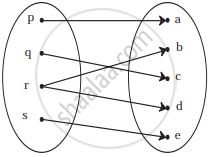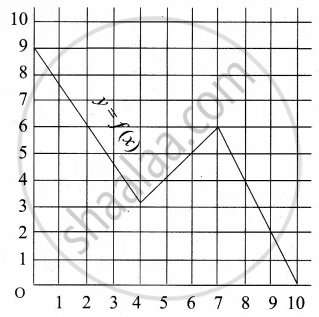Advertisements
Advertisements
प्रश्न
If f, g and h are real functions defined by
उत्तर
Given:
⇒ x ≥-1
⇒ x ∈ [-1, ∞]
Thus, domain ( f ) = [-1, ∞] .
Clearly, g (x) is defined for x ≠ 0 .
⇒ x ∈ R – { 0} and h(x) is defined for all x such that x ∈ R .
Thus,
domain ( f ) ∩ domain (g) ∩ domain (h) = [ -1, ∞] – { 0}.
Hence,
(2f + g – h) : [ -1, ∞] – { 0} → R is given by:
(2f + g – h)(x) = 2f (x) + g (x) -h (x)
(2f + g – h) (0) does not exist because 0 does not lie in the domain x ∈[ - 1, ∞] – {0}.
APPEARS IN
संबंधित प्रश्न
Let f : R → R and g : C → C be two functions defined as f(x) = x2 and g(x) = x2. Are they equal functions?
f, g, h are three function defined from R to R as follow:
(i) f(x) = x2
Find the range of function.
Let X = {1, 2, 3, 4} and Y = {1, 5, 9, 11, 15, 16}
Determine which of the set are functions from X to Y.
(a) f1 = {(1, 1), (2, 11), (3, 1), (4, 15)}
Write the range of the function f(x) = sin [x], where \[\frac{- \pi}{4} \leq x \leq \frac{\pi}{4}\] .
If \[f\left( x \right) = \log \left( \frac{1 + x}{1 - x} \right)\] , then \[f\left( \frac{2x}{1 + x^2} \right)\] is equal to
If x ≠ 1 and \[f\left( x \right) = \frac{x + 1}{x - 1}\] is a real function, then f(f(f(2))) is
If f(x) = cos (loge x), then \[f\left( \frac{1}{x} \right)f\left( \frac{1}{y} \right) - \frac{1}{2}\left\{ f\left( xy \right) + f\left( \frac{x}{y} \right) \right\}\] is equal to
If \[f\left( x \right) = \frac{\sin^4 x + \cos^2 x}{\sin^2 x + \cos^4 x}\] for x ∈ R, then f (2002) =
The domain of definition of the function \[f\left( x \right) = \sqrt{x - 1} + \sqrt{3 - x}\] is
The domain of definition of \[f\left( x \right) = \sqrt{x - 3 - 2\sqrt{x - 4}} - \sqrt{x - 3 + 2\sqrt{x - 4}}\] is
Check if the following relation is function:

Which of the following relations are functions? If it is a function determine its domain and range:
{(2, 1), (4, 2), (6, 3), (8, 4), (10, 5), (12, 6), (14, 7)}
Find x, if g(x) = 0 where g(x) = 6x2 + x − 2
Find the domain and range of the following function.
f(x) = 7x2 + 4x − 1
Find the domain and range of the following function.
g(x) = `(x + 4)/(x - 2)`
Find the domain and range of the following function.
f(x) = `root(3)(x + 1)`
Express the area A of circle as a function of its circumference C.
Select the correct answer from given alternatives
The domain of `1/([x] - x)` where [x] is greatest integer function is
Answer the following:
Show that, `log ("a"^2/"bc") + log ("b"^2/"ca") + log ("c"^2/"ab")` = 0
Answer the following:
If `log"a"/(x + y - 2z) = log"b"/(y + z - 2x) = log"c"/(z + x - 2y)`, show that abc = 1
Answer the following:
Find the domain of the following function.
f(x) = `(x^2 + 4x + 4)/(x^2 + x - 6)`
Find the domain of the following function.
f(x) = `sqrtlog(x^2 - 6x + 6)`
Given the function f: x → x2 – 5x + 6, evaluate f(2)
A graph representing the function f(x) is given in it is clear that f(9) = 2

Find the following values of the function
(a) f(0)
(b) f(7)
(c) f(2)
(d) f(10)
Find the domain of the following function.
f(x) = [x] + x
Redefine the function which is given by f(x) = `|x - 1| + |1 + x|, -2 ≤ x ≤ 2`
Find the domain of the function f given by f(x) = `1/sqrt([x]^2 - [x] - 6)`
The domain of the function f defined by f(x) = `1/sqrt(x - |x|)` is ______.
If f(x) = `x^3 - 1/x^3`, then `f(x) + f(1/x)` is equal to ______.
Find the domain of the following functions given by f(x) = `1/sqrt(1 - cos x)`
Redefine the function f(x) = x − 2 + 2 + x , – 3 ≤ x ≤ 3
If f(x) = `(x - 1)/(x + 1)`, then show that `f(1/x)` = – f(x)
The domain and range of real function f defined by f(x) = `sqrt(x - 1)` is given by ______.
If f(x) = `log_e{((1 - x))/((1 - x))}, |x| < 1, f{(2x)/((1 + x^2))}` is equal to ______.
